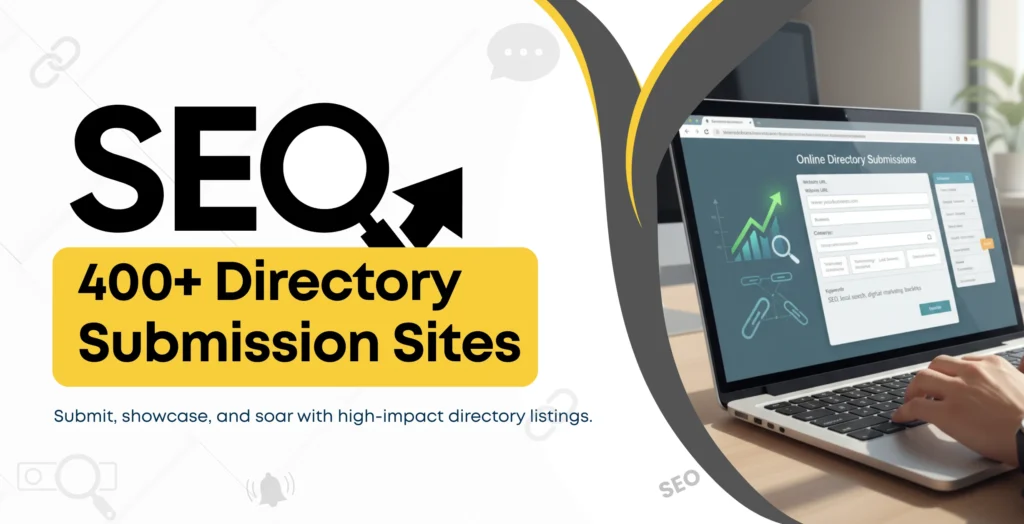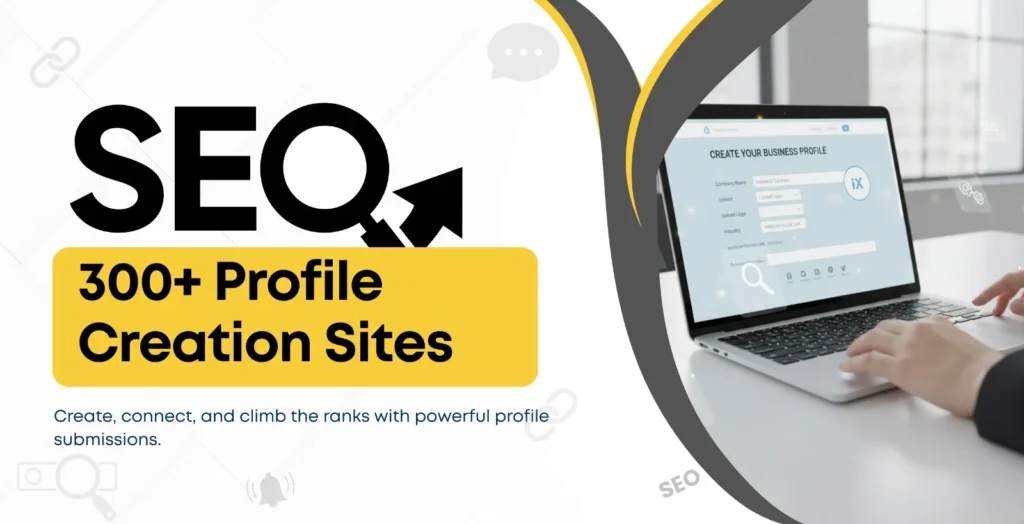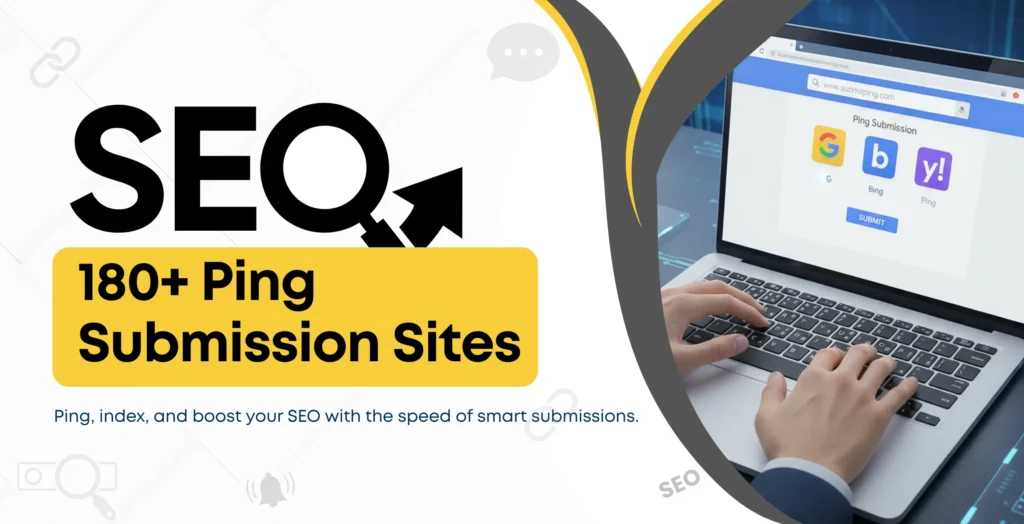Digital transformation has caused a significant change in the education industry, where institutions are reconnecting and communicating with students through digital transformation. Technology has taken the shape of the backbone of contemporary education through online applications in admissions to virtual classrooms. With the current generation of learners, and Gen Z in particular, relying on search engines, social media, and online reviews, a robust online presence is now more than ever essential prior to making an academic choice.
Schools have become competitive on the internet in matters of visibility, trust, and enrolment. An effective digital strategy can be used to make schools, coaching centers, colleges, and EdTech brands unique, connect with the target audience, and increase participation.
This blog will cover the Top Digital Marketing Strategies for the Education Industry these are the time-tested strategies that can assist institutions to gain proximity, earn reputation, and achieve quantifiable growth in the digital age.
Benefits of Digital Marketing in the Education Sector
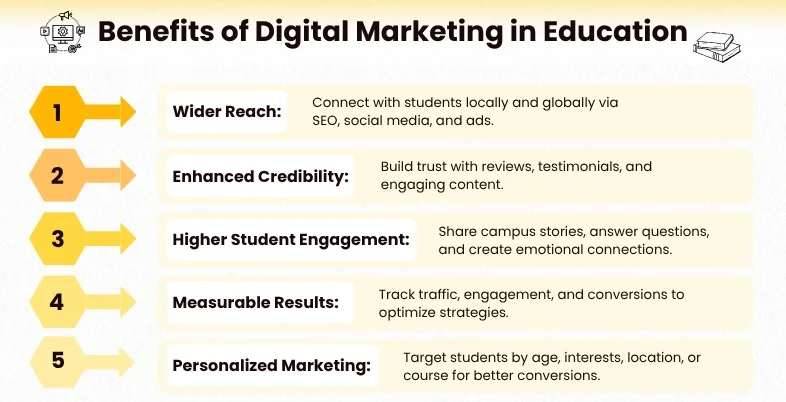
Online marketing has transformed the way learning institutions are being attracted and reached. The old marketing, such as brochures and newspaper advertisements, is no longer able to compete with the level of reach and customization that online platforms can provide. Since 90% of students study colleges and courses on the Internet and only then apply, the school, colleges, coaching centers are investing in digital marketing receive an enormous advantage in terms of being seen and trusted.
Greater Extent of Reach and Availability:
Institutions can connect to students in various regions and even countries using SEO, social media as well and paid advertisements. Online visibility eliminates geographical boundaries and generates applicants across the world.
Enhanced Brand Credibility:
There must be a great online presence – with reviews, testimonials, and interesting content, creating confidence in potential students and parents. A study conducted by Google revealed that 67% of students use the online reputation of an institution before they apply.
Higher Student Engagement:
There is two-way communication with social media sites and email campaigns. Institutions are able to post stories on their campuses, answer questions, and create emotional bonds with their readers.
Information-Based and quantifiable ROI:
Digital campaigns are able to be monitored and evaluated in real time, unlike traditional advertising. Measures such as conversion rates, level of engagement, and traffic to the site are effective in gauging performance and refining the strategies that are in operation.
Personalized Marketing to the Right Person:
By using the services of platforms such as Google Ads or Facebook Ads, the institutions have the opportunity to focus their attention on a particular demographic group, which can be students by age, interest, location, or course preference, which will result in increased conversion potential.
To the point, digital marketing helps educational organizations to reach the right students, build real relationships, and reach quantifiable growth in a data-driven age.
15 Best Digital Marketing Strategies for the Education Industry
1. Build a User-Friendly and Responsive Website
The digital presence is based on a well-designed site. It forms the initial contact between the students and your institution. A responsive website makes sure that there is smooth access on desktops, tablets, and mobile devices. It should have a high loading rate, navigation clarity, and easy access to course details.
Engagement can be enhanced by adding interactive features like live chat, virtual tours as well and inquiry forms. Powerful calls-to-action (CTAs) prompt the visitors to contact, apply, or reserve campus visits. A professional site also enhances credibility, which makes the parents and the students trust your institution.
Key Points:
- Make sure mobile responsiveness and quick loading of pages.
- Make emphasis on courses, achievements, and admission information.
- Add visually vivid CTAs and interactivity.
2. Invest in SEO to Boost Online Visibility
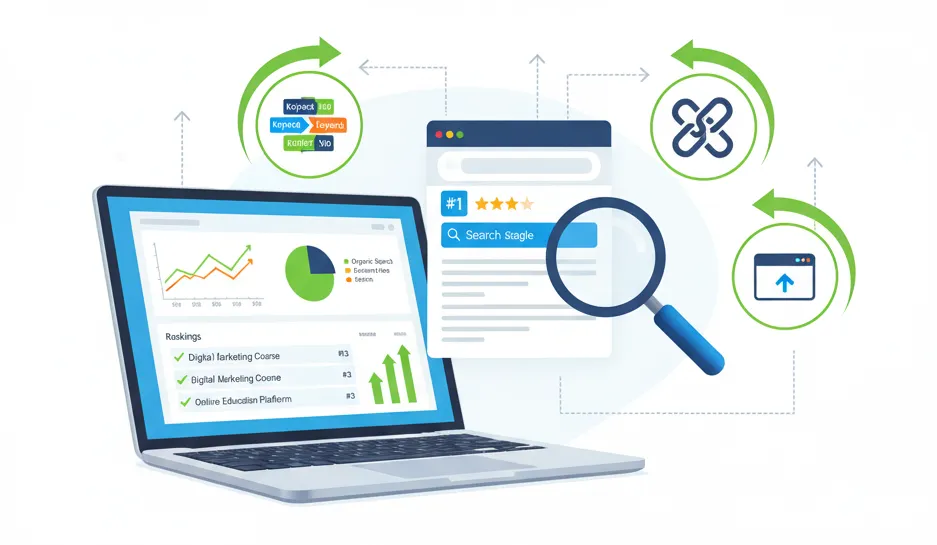
Search Engine Optimization (SEO) is essential in the attraction of organic traffic. It will make your institution be ranked in the search engine when students search online for programs. The use of keywords such as best MBA college in India or online coding courses will make sure that your site is ranked well. On-page (titles, meta description, headings) and off-page SEO (guest posts, backlinks) will help to improve the ranking.
Local search is also necessary to appeal to local students. Incorporation of constantly updated content is also a way to improve authority. Through the investment in SEO, your institution is able to reach the right audience and build credibility, as well as lessen reliance on paid advertising.
Key Points:
- Search using relevant keywords and search phrases.
- Maximize on meta tags, headings, and URLs.
- Get your building quality backlinks and local search optimization.
3. Leverage Content Marketing to Educate and Inspire
The concept of content marketing assists colleges in establishing themselves as thought leaders. You can capture potential students by producing valuable content and also take them through the process of enrollment. Prospects respond to blogs, guides, eBooks, and infographics that relate to the process of overcoming common challenges, such as exam tips, career guidance, or scholarship advice.
Posting student success stories or interviews with faculty can be very authentic and tend to be more emotional. High-quality and frequent content also improves the performance of SEO and enhances the brand image. Before selling, educating institutions are likely to gain trust and long-term loyalty from their students and parents.
Key Points:
- Create blogs, guides, and infographics that meet student needs.
- Post alumni and student success stories.
- Engage audiences through telling stories.
4. Harness the Power of Social Media Marketing
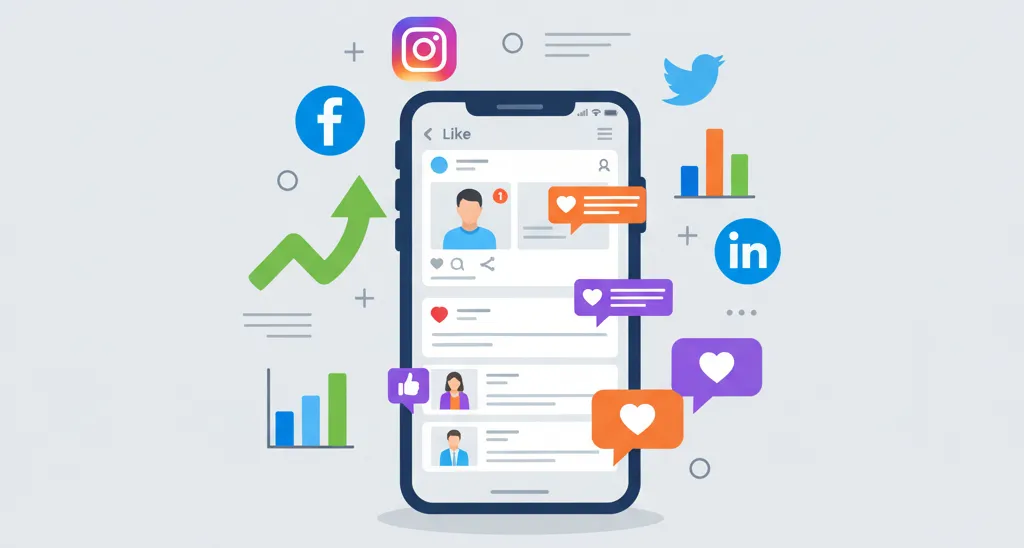
The social media platforms are crucial to contact and interact with students, like Instagram, LinkedIn, YouTube, and Facebook. Publicity of life on campus, campus events, student performance, and faculty knowledge make the brand more humane. Reels, stories, and live sessions that are used to visually tell stories stimulate the interaction.
Social media also allows two-way communication, where students can pose questions and experiences. Social advertising campaigns are also paid for in order to increase coverage to the targeted demographics. Regular and systematic social media would enhance brand recognition, create interest, and aid the recruitment of students.
Key Points:
- Don’t be afraid to post interesting, real content regularly.
- Interact through graphics, reels, and live.
- Carry out specific social advertising to target potential students.
5. Run Targeted PPC (Pay-Per-Click) Campaigns
The PPC campaigns enable the institutions to feature as the top results or social feeds immediately. Google Ads, Facebook Ads, and Instagram Ads allow focusing on age, location, interests, and search patterns. Effective ad copy, quality images, and best-optimized landing pages will raise the likelihood that they will be converted. Students who visited your site but did not register can be retargeted through retargeting campaigns.
It is better to monitor metrics like click-through rate (CTR) and cost per conversion to guarantee better ROI. PPC is a quick and quantifiable method of generating enrollment leads to supplement larger marketing efforts.
Key Points:
- Maximum relevance should be achieved by targeting high-intent keywords.
- Design appealing advert creatives that have definite CTAs.
- Re-engage visitors and monitor conversion behaviour.
6. Implement Email Marketing for Lead Nurturing
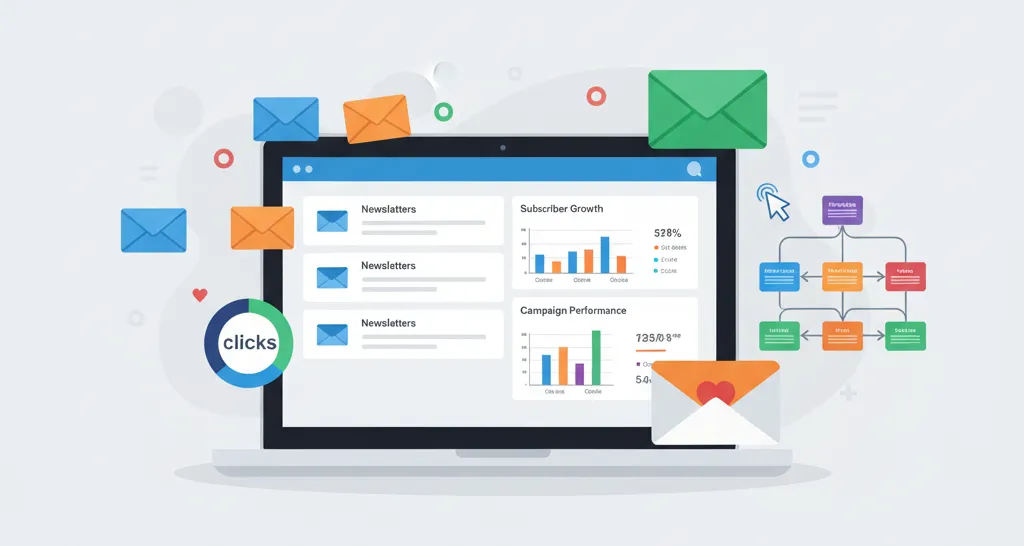
Email marketing assists in fostering potential students by way of personal communications. Dividing email lists will enable institutions to deliver course-related communications, scholarship notifications, invitations to events, and application reminders. Drip campaigns are auto-driven methods that lead the revolving process of enrolling.
Open rates are enhanced with the use of sexy templates, powerful subject lines, and actionable content. Informing and promotion emails should be balanced to ensure institutions build trust and enhance conversions. Email marketing is also cost-effective and quantifiable, with all the important information on the level of engagement and campaign success.
Key Points:
- Target audiences based on programs and areas of interest.
- Lead nurturing: Use automated drip campaigns.
- Monitor open, click-through rate, and conversion rate.
7. Use Video Marketing to Tell Your Story
Video marketing attracts students, unlike text or images. There are virtual campus tours, student testimonials, faculty interviews, and course overviews that will enable the prospects to virtually experience your institution. Videos are very viral and enhance the search engine optimization with titles, descriptions, and tags. Social media platforms such as YouTube, Instagram Reels, and TikTok are the best to target students.
Through the integration of storytelling with professional production, institutions will be able to establish emotional attachment, brand recognition, which and lead to inquiries. Webinars and Q&A sessions will also be utilized to add interaction, as the sessions will be live.
Key Points:
- Make campus tours and testimonial videos.
- Have short-term videos on social media.
- SEO and use of clear call to actions on videos.
8. Collaborate with Influencers and Alumni
Credibility and relatability are improved using influencer and alumni marketing. Students are more convinced by real experiences rather than traditional advertising. One way to enhance your message is by working with micro-influencers or education bloggers, or popular alumni. Provide examples of alumni success stories on social media, website, and webinars to show real results.
Conducting live Q&A with former students will enable them to establish trust by having open communication with them. Showcasing real-life experiences will make it more exciting and motivate an application, and also make your institution look like a credible option in the saturated education market.
Key Points:
- Make friends with education or career advisors.
- Make an appearance on alumni success stories on platforms.
- Conduct a live Q&A to respond to the questions of students.
9. Adopt Marketing Automation Tools

Marketing automation increases efficiency through simplification and personalization of communication. Such tools as HubSpot, ActiveCampaign, or Zoho CRM enable institutions to execute email campaigns, follow-ups, and lead scoring with the help of automation. The engagement will be high because messages will be more relevant by dividing students according to their preferences and behavior.
Students’ engagement is also tracked through automation to offer insights on how to maximise campaigns. The institutions can keep steady communication with the prospective students without straining the efforts of the institution, and none of the leads can be lost in the admission process.
Key Points:
- Automate emails, reminders, and lead nurturing processes.
- Differentiate students in order to reach them individually.
- Optimize campaigns by the use of data analytics.
10. Focus on Local SEO for Nearby Students
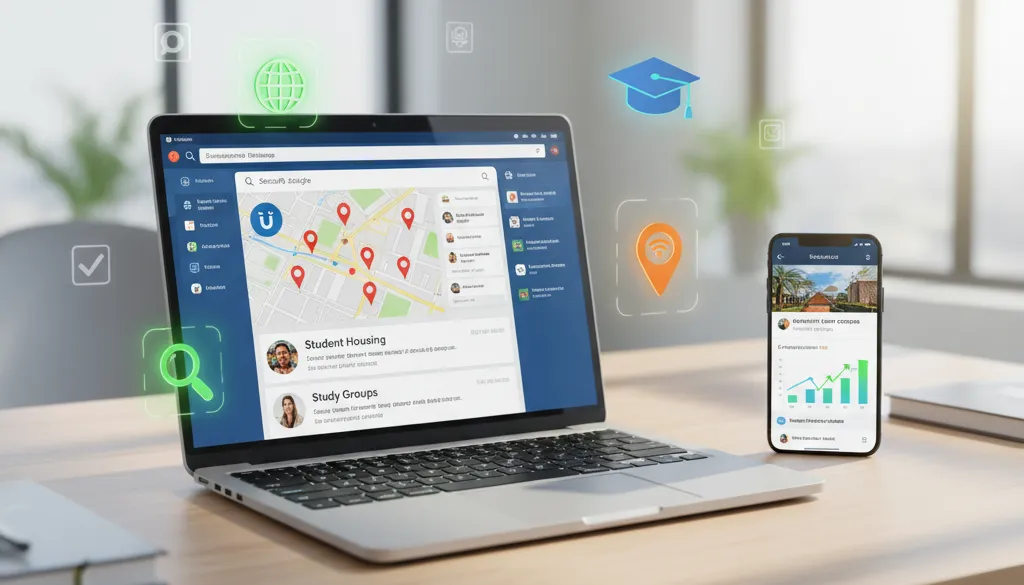
Local SEO assists institutions in attracting students in their immediate areas on the internet in search of their courses. Local search Google My Business Profiles can be optimized, and NAP (Name, Address, Phone) information should be kept consistent and positive reviews.
Images and content based on location make it more relevant. Schools, colleges, and coaching centers that are oriented in a particular city or region are especially effective with local SEO. Being high on local searches will mean that you have the right leads to your institution and are converting them effectively.
Key Points:
- Enhance Google My Business with proper data.
- Gather and react to student evaluations.
- Produce local keywords and image content.
11. Strengthen Your Brand Identity Online
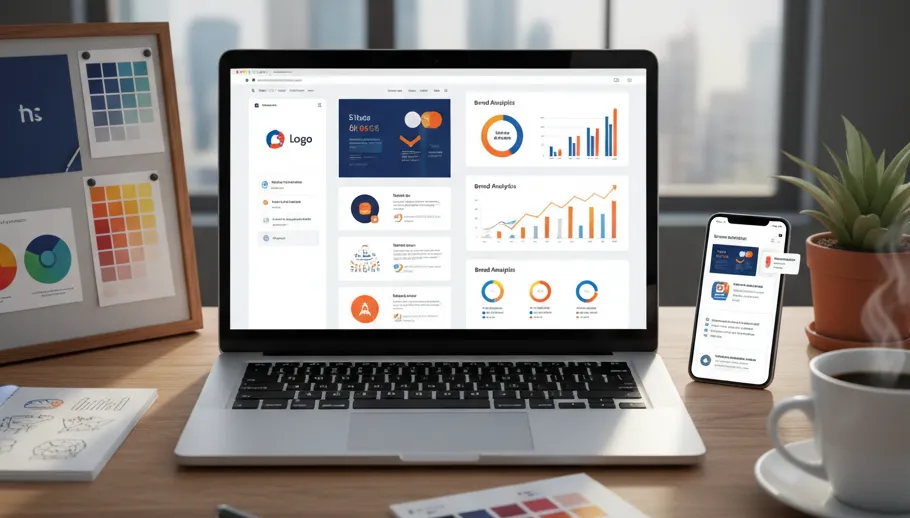
Trust and recognition are gained through a solid and concurrent brand identity. Every digital interaction point (social media, emails, websites, advertisements) must be in line with your institution, its values, voice, and visual style. A unified brand is what makes your institution stand out from the crowd and is an appeal to the emotions of students and parents.
Be consistent in sharing your mission, values, and your achievements in order to leave a memorable presence. Interesting content, realistic imagery, and an understandable tone can be used to build credibility and foster loyalty among potential students.
Key Points:
- Use similar colors, fonts, and logos.
- Enhance mission, culture, and values on platforms.
- Appeal to the human heart by using real images and narratives.
12. Incorporate Chatbots for Instant Student Support

AI chatbots are available 24/7, responding to frequently asked questions in real-time and directing visitors through the admissions, programs, and scholarships. Chatbots are easier to use, faster to respond to, and lead capture is better. Connection with websites, social media, and message services guarantees a smooth communication process.
The chatbots will also be able to gather student preferences and information to assist the marketing team in tailoring their follow-ups. Chatbots enhance interaction and trust by offering instant help, thus making the prospects more likely to become enrolled students.
Key Points:
- Provide chat robot support.
- Gather information to conduct individual follow-ups.
- Integrate on several platforms to make it convenient.
13. Optimize for Mobile Marketing
Mobile marketing is the best way of targeting students because they spend the majority of their time using mobile devices. Mobile-optimized websites, landing pages, emails, and advertisements increase the user experience. Timely updates about admissions, scholarships, or events could be provided using SMS campaigns and push notifications.
Social media campaigns and video content can also be supported by mobile marketing, which will reach its maximum potential. The rapid loading and responsive designs will ensure a higher number of people convert and prove that your institution is sensitive to the needs of a mobile-first audience.
Key Points:
- Create reactionary websites and landing pages.
- Employ SMS and push notifications.
- Mobile email and ads optimization.
14. Track and Analyze Performance Metrics
Analytic thinking is essential in the enhancement of marketing ROI. Such tools as Google Analytics, SEMrush, or HubSpot enable the institutions to monitor the traffic of their websites, conversions, engagement, or ads.
Determining the successful campaigns aids in maximizing the budgets and resources. KPIs established include the number of leads, the cost per enrollment, and the engagement rates, which should be continuously improved by constantly monitoring them. It is also in data analysis that one can make the most effective decisions and make the other forms of digital marketing more effective.
Key Points:
- Keep track of the metrics of the websites, social, and email.
- Make changes to strategies by performance data.
- Report and have real-time insights using dashboards.
15. Stay Ahead with Emerging Digital Trends

Institutions have to be active in embracing the new digital trends in order to be competitive in the education sector. Student engagement is being redesigned with the use of technologies such as Artificial Intelligence (AI) to customize the experience, Augmented Reality (AR) and Virtual Reality (VR) to provide immersive learning and campus tours, and optimization of voice search.
The use of gamification, interactive teaching, and predictive analytics will assist in attracting and retaining potential students. By trying such innovations, not only does the institution improve user experience, but it also markets itself as an innovative, progressive, and student-focused organization. Trendsetting is one way to stay more visible, engage more, and have a stronger competitive advantage in the online realm.
Key Points:
- Use AI, AR/VR, and voice search to enhance interaction.
- Interactive content and gamification can be used to engage students.
- Embrace new technologies to stay ahead.
Suggested Read: Digital Marketing Strategies for Healthcare and Pharma
Future Trends in Education Digital Marketing.
- Artificial Intelligence Personalization: Artificial Intelligence will enable institutions to provide students with an exceptionally personalized experience. Individualized suggestions on courses will make every engagement feel unique, and customized emailing will do the same. This enhances interaction, sales, and general satisfaction of the students.
- Voice Search Optimization: Voice search is becoming popular among students as they use it to locate courses and programmes due to the emergence of smart devices. Organizations will be forced to optimize their content for natural language queries. Voice-friendly content makes it visible and easier to learn about your institution among the prospects.
- AR / VR Campus Tours: Augmented Reality (AR) and Virtual Reality (VR) will change the way students tour campuses remotely. Potential students can have an interactive campus tour, participate in online events, or have a sense of a classroom before walking into a real classroom. This virtual experience leads to greater interaction and recruitment.
- Predictive Analytics: Sophisticated analytic systems enable organizations to predict student interests and behaviors. Through the analysis of data on visits and social media as well as previous interactions, the marketers can refine their strategies and personalize campaigns. This increases conversion rates and better allocation of resources.
- Chatbots and Automation: Chatbots will be used to provide 24/7 services and answer queries by the students using AI. Robotized responses, involved reminder, and customized guidance save on workload to staff and enhance response time. Automation means that no potential student will be left without an answer.
Conclusion
Online marketing is no longer optional for educational institutes it is essential for growth and visibility. By implementing the 15 strategies outlined in this blog, including creating a responsive website, optimizing search engines, leveraging social media and video marketing, and using marketing automation, institutions can effectively reach their target audience, build credibility, and increase enrollment.
Additionally, by adopting emerging technologies such as AI, AR/VR, and voice search, schools, colleges, and EdTech brands can stay ahead in the rapidly evolving digital landscape. These Digital Marketing Strategies for the Education Industry enable institutions to engage students meaningfully, deliver personalized experiences, and achieve measurable results, setting themselves apart as leaders in education.
FAQs
Why should educational institutions adopt digital marketing?
Online marketing assists institutions in connecting with students online, developing reputations, reaching out to potential students, and gauging outcomes properly. All the students researching the courses online will require a good presence on digital platforms in order to be seen and enroll.
Which are the best digital marketing outlets in the case of schools and colleges?
The best channels when communicating with students and promoting educational programs are websites, social media (Instagram, YouTube, LinkedIn), email marketing, SEO, and paid advertisements.
Can social media enhance student engagement?
Through social media, the institutions can distribute updates on campus, activities, successes, and interactive materials. It forms a community, fosters two-way interaction, and establishes feelings with future students.
How will AI be used in the marketing of education in the future?
The AI provides recommendations based on personal preferences, automation of communication, predictive analytics, and chatbots, enhancing the level of engagement, conversions, and satisfaction among the students.
What are the ways of digital marketing ROI measurement by institutions?
With the help of analytics tools, institutions can monitor traffic on the websites, lead generation, performance of ads, email interactions, and conversion. Such measurements allow for maximizing the strategies and proving ROI.


